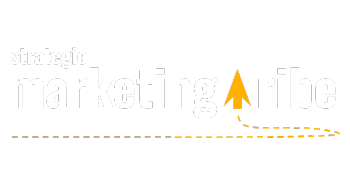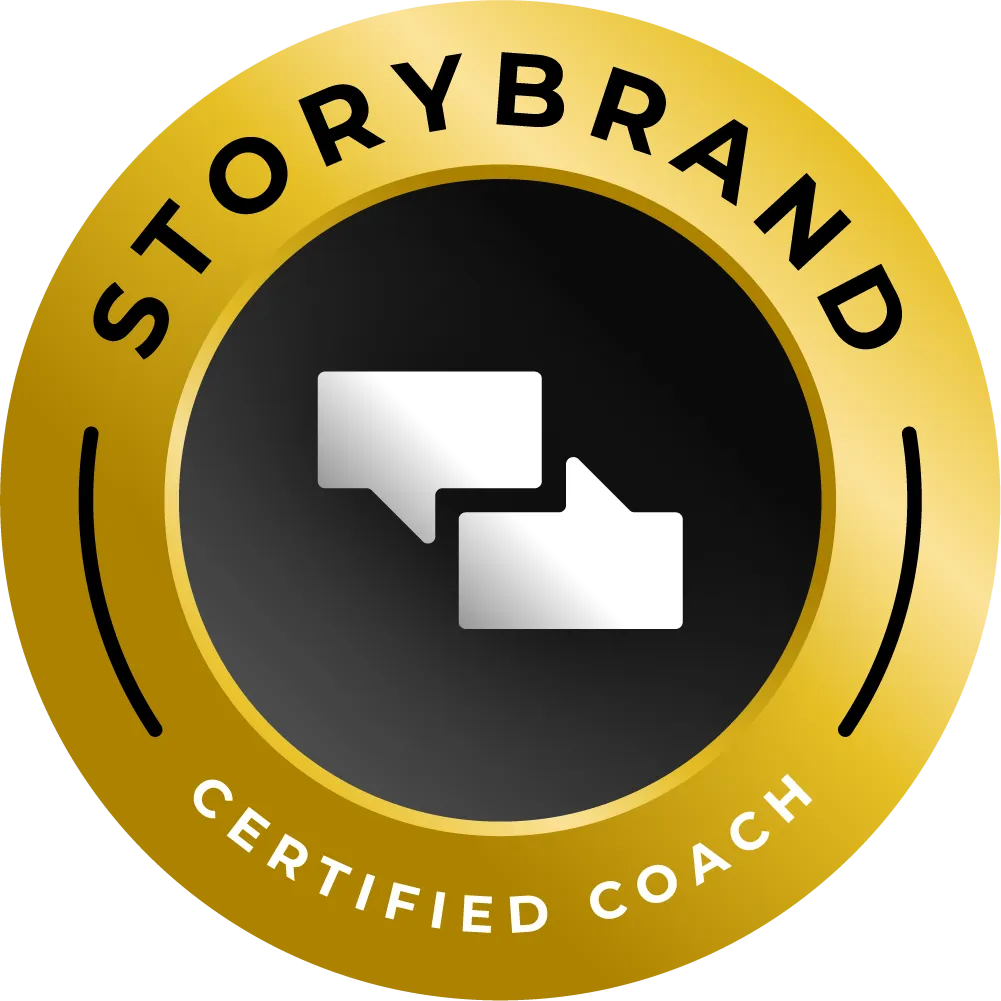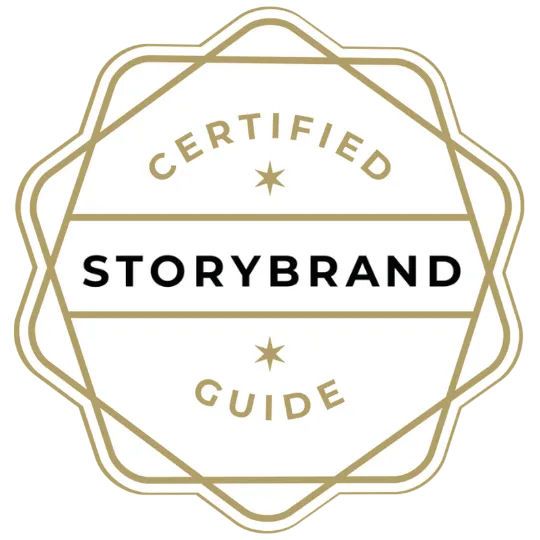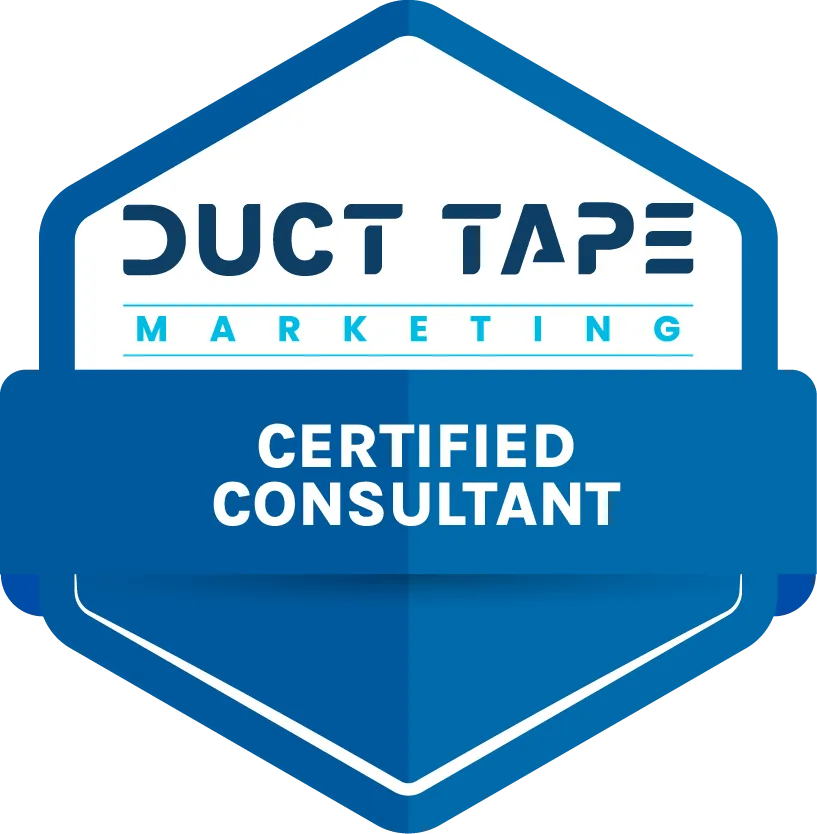STORY, MEET STRATEGY
Let’s make marketing feel less robotic and more real.
Find resources that bring your message – and your business – to life.

Mastering StoryBrand Marketing: Your Guide for 2025
What You Can Expect:
Why Most Marketing Misses the Mark
The Framework That Changes Everything
From Late Fees to Binge-Watching—The Story of a Streaming Giant
2025 is the year to stop talking about yourself. Let me explain.
Recently, a client told me something that really resonated: “It feels like the robots are just talking to each other now. I send an email written by AI, I get a reply with one written by AI, and it’s just AI talking to AI.” He wasn’t wrong. Everywhere you look, generic messaging is taking over—quick, easy, and utterly forgettable. It’s time to reclaim marketing from the machines.
Imagine standing in a bookstore. You’re not looking for anything specific, but you wander down an aisle and spot a book with a simple, intriguing title. You pick it up, flip through the first page, and suddenly you’re hooked. It’s not the cover or the font—it’s the story. It’s speaking to you, as if the author peered into your life and wrote something just for you.
That’s what great marketing feels like. It’s not banging on about how amazing your product is. It’s crafting a message so compelling, so relevant, that your customer leans in and thinks, This is exactly what I need.
I’m Vicky Sidler, a StoryBrand Certified Guide, and I’ve spent years helping businesses create messages that truly resonate. Marketing seems complex, but it doesn’t have to be. With the StoryBrand Framework, you can create a narrative that doesn’t just grab attention but connects on a human level.
Let’s make 2025 the year your marketing feels real again—clear, simple, and impossible to ignore.
Why Most Marketing Misses the Mark
But first, let’s start with a story. In 2012, JCPenney tried something bold. With a new CEO at the helm—Ron Johnson, the retail visionary behind Apple’s iconic stores—the company decided to eliminate their endless coupons and sales. Instead, they introduced a simplified “Fair and Square” pricing strategy. Prices were slashed by 40%, and a three-tier system was introduced: everyday low prices, month-long promotions, and clearance events.
On paper, it made sense. Customers love good deals, so why not make every day a deal? Johnson believed shoppers were tired of the constant sales gimmicks and wanted simplicity. But what he missed was the psychology behind the hunt.
JCPenney’s customers weren’t just buying shirts or curtains; they were buying the satisfaction of scoring a bargain. The thrill of clipping coupons, hunting for discounts, and walking away with a “win” was an integral part of the experience. Without that, shopping at JCPenney felt... ordinary.
The result? A staggering 25% drop in sales within a year. Loyal customers felt alienated, confused, and uninspired. The company had fundamentally misunderstood what its audience valued most—not low prices, but the emotional reward of finding them.
This story isn’t just a cautionary tale; it’s a masterclass in what happens when businesses focus on their own logic instead of their customers’ motivations. JCPenney’s strategy looked brilliant in a boardroom presentation but failed because it didn’t address the emotional connection customers had with the brand.
The lesson is clear: marketing isn’t just about the product or service—it’s about the story you tell and the feelings you evoke. Even the best products can falter if the message doesn’t resonate.
The Framework That Changes Everything
And that’s where StoryBrand comes in. Created by Donald Miller, the StoryBrand Framework is a revolutionary way to approach marketing that focuses on what truly matters to your customers. At its core, the framework is about clarity—helping businesses shift their focus from themselves to their customers.
Don’s insight is as straightforward as it is powerful: your customer is the hero of your story, not your brand. Too many businesses fall into the trap of talking endlessly about themselves—their history, their accolades, their features—without ever addressing the problems their customers are facing. The StoryBrand Framework flips that script.
Instead of making yourself the star of the story, the framework positions your brand as the guide—the steady, empathetic mentor who helps your customer succeed. When done well, this approach doesn’t just grab attention; it builds trust and loyalty.
Let’s break it down using JCPenney’s failed pricing strategy.
1. A Hero
Your customer is the star. They’re not looking for a lecture or a saviour—they want a solution to their problem. In JCPenney’s case, their customers were deal-hunters who loved the thrill of snagging a great discount.
2. A Problem
Every hero faces conflict. In the StoryBrand Framework, that conflict comes in three forms:
External: The tangible issue they need to solve (e.g., finding affordable fashion).
Internal: The emotional struggle tied to that issue (e.g., the satisfaction of scoring a deal).
Philosophical: The bigger belief they hold about what’s fair or right (e.g., “Good value should feel like a reward”).
3. A Guide
Customers don’t need a hero; they need a guide—someone who understands their struggles and offers a trusted solution. In the StoryBrand Framework, the guide’s role involves two key elements:
Empathy: Show that you understand their struggles. This is about connecting on a human level. (e.g., “We know you love finding great deals—that’s why we’ve designed our sales just for you.”)
Authority: Demonstrate that you have the expertise and tools to help them succeed. (e.g., “With decades of retail experience, we’ve helped millions save on their favourite brands.”)
The guide isn’t the star of the story—that’s the customer. But the guide’s empathy and authority make the hero feel confident they’ve chosen the right partner for their journey.
4. A Plan
Heroes need a roadmap to succeed. In the StoryBrand Framework, the plan is about offering clear, simple steps to remove confusion and create momentum. For example:
Step 1: Browse our sales.
Step 2: Use your coupons.
Step 3: Save big on the brands you love.
The simpler the plan, the more confident your customers will feel about taking action.
5. A Call to Action
A clear, direct call to action tells customers what to do next. “Shop our latest sale” or “Redeem your coupon today” gives them a reason to act immediately. The call to action removes hesitation by telling them exactly what to do next, reducing decision fatigue.
6. Avoiding Failure
What happens if the hero doesn’t act? Highlighting the consequences of inaction is a powerful motivator. Customers need to know what’s at stake.
Example: “Miss this sale, and you could lose out on your favourite styles for half the price.”
This isn’t about fearmongering; it’s about showing them what they stand to lose if they stay stuck.
7. Success
Lastly, show your customers what success looks like—a vivid picture of the better future you’re offering. For JCPenney’s deal-hunting customers, success was more than savings; it was the thrill of achieving those savings.
Success isn’t just about solving the problem; it’s about delivering an emotional payoff that sticks with your customers long after the transaction.
JCPenney’s mistake wasn’t in trying to improve—it was in failing to understand their customers’ deeper motivations. They removed the thrill of the deal, breaking the emotional connection their shoppers had with the brand. The StoryBrand Framework reminds us that the best marketing doesn’t just solve problems—it taps into emotions and beliefs, creating a story customers want to be part of.
From Late Fees to Binge-Watching—The Story of a Streaming Giant
Let’s look at how Netflix mastered this approach, redefining an entire industry by addressing external frustrations and internal desires at the same time.
Netflix didn’t start as the streaming powerhouse we know today. In fact, its journey began with something as mundane as a late fee. Co-founder Reed Hastings was hit with a $40 penalty for not returning Apollo 13 on time. That frustration sparked an idea: what if renting movies didn’t come with penalties or guilt?
The Netflix we know today started in 1997 as a DVD-by-mail rental service, tackling three levels of customer problems:
External Problem: Renting movies was inconvenient—trips to the store, limited selections, and high fees. Netflix solved this by delivering DVDs to your door.
Internal Problem: The anxiety of late fees loomed large. Netflix eliminated them with a subscription model in 1999, giving customers peace of mind.
Philosophical Problem: People believed that entertainment should be easy and enjoyable, not stressful or punitive. Netflix made watching movies feel guilt-free.
By addressing these layers of frustration, Netflix didn’t just compete with Blockbuster; it redefined the experience entirely. Customers weren’t just renting movies—they were buying convenience, freedom, and peace of mind.
When streaming technology emerged, Netflix didn’t abandon its story. Instead, it adapted, evolving its message to fit the times. The focus remained the same: easy, accessible, and guilt-free entertainment. Streaming was simply the next logical step in delivering on that promise.
The company’s pivot wasn’t just a technological upgrade; it was a continuation of its customer-centric narrative. By releasing entire seasons of shows at once, Netflix introduced the concept of binge-watching, transforming how audiences consumed content. This wasn’t just a clever strategy—it was a direct response to what customers wanted: control over their entertainment.
Netflix’s journey shows that staying customer-focused isn’t just about solving surface-level problems. It’s about digging deeper, understanding emotional frustrations, and responding with solutions that feel personal. This philosophy helped Netflix reshape an industry, proving that the right story can create loyal customers and a lasting legacy.
Why StoryBrand Works
Here’s the simple truth: no one wakes up excited to hear about your brand. They wake up thinking about themselves—their to-do lists, their goals, and their problems. That’s why the StoryBrand Framework resonates. It speaks directly to your customer’s internal monologue.
It’s not about flooding everyone’s feeds with more content or using AI to spit out 1,000 generic words in seconds. It’s about standing out by making your customer feel seen. It works because it mirrors how humans naturally think and connect: through stories. A good story doesn’t just inform—it transforms. It makes someone care.
As in the Netflix example, their story didn’t start with cutting-edge streaming or binge-watching. It started with a frustration many of us can remember all too well: late fees. By recognising that emotional pain point and addressing it head-on, Netflix didn’t just compete with Blockbuster—they became a brand customers felt loyal to.
When you use the StoryBrand Framework, you stop trying to impress people with your features or accolades. Instead, you start solving their problems, addressing their frustrations, and inviting them into a story where they’re the hero. The framework’s power lies in its ability to simplify and humanise your message, making it relatable, memorable, and actionable.
The Future of Marketing: Authenticity in 2025
2025 is the year to move away from flashy buzzwords and AI-generated filler. It’s time to lean into authenticity. The brands that win will be the ones telling stories their customers can’t ignore.
If you’re ready to make this a reality, download my free ebook, Avoid Common StoryBrand Mistakes. It’s packed with practical tips and examples to help you create a message that resonates. Let’s make 2025 the year your story gets heard.
Looking For More?
This blog is part of a weekly series where we tackle different aspects of mastering StoryBrand marketing for 2025. Each week, we’ll break down the framework step by step, using real-life examples to help you craft a message that resonates.
Start with our first article: The Coffee Truck That Outsmarted Starbucks: A Story About Marketing That Works. It’s a compelling example of how focusing on your customers' needs—not your own—can transform your marketing and boost your growth.
READY TO MAKE YOUR MESSAGE MATTER?
Enough with the bland, forgettable, soulless AI Content – we design StoryBrand marketing that feels human and actually connects.
Cleared with clarity (and coffee)
